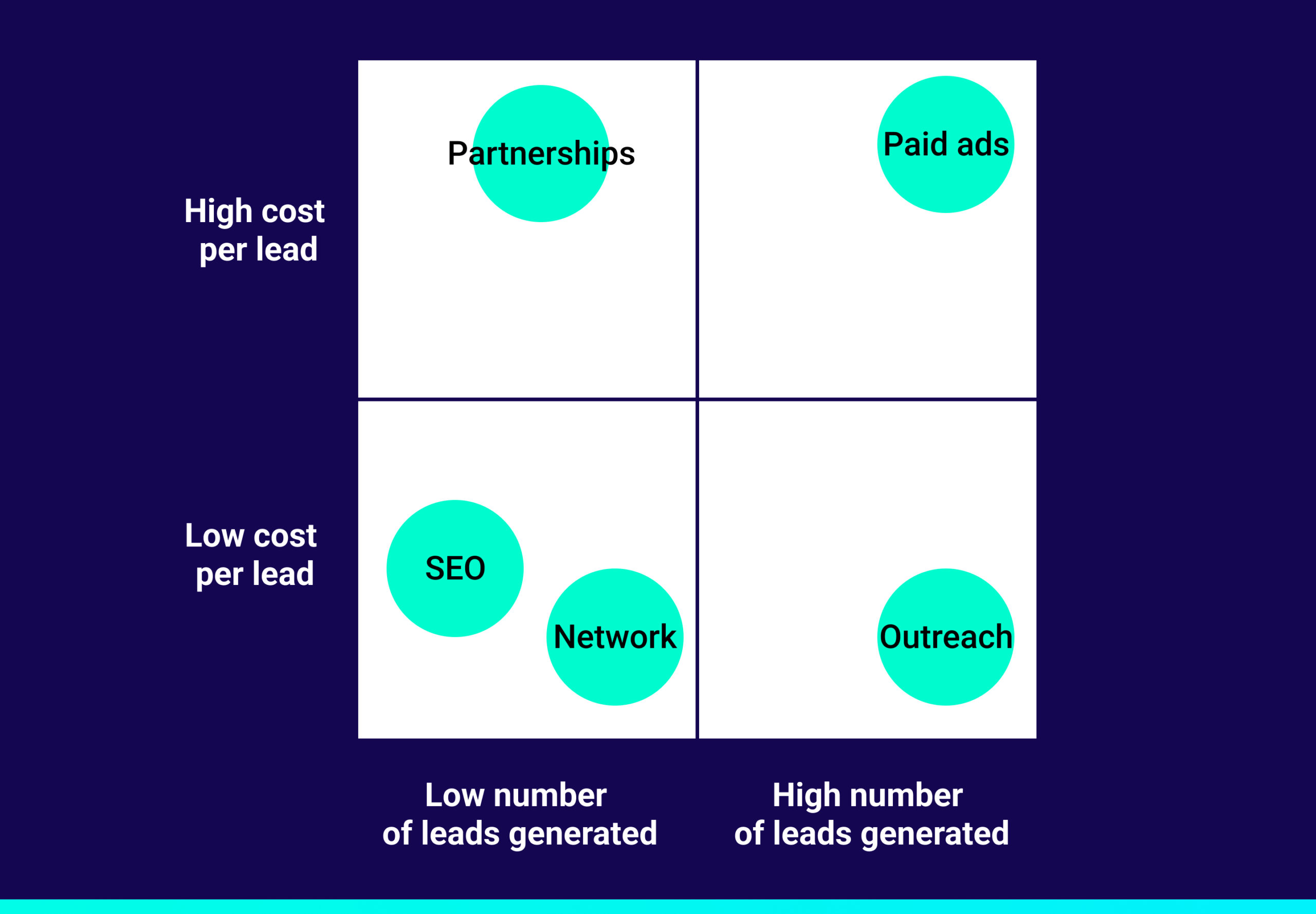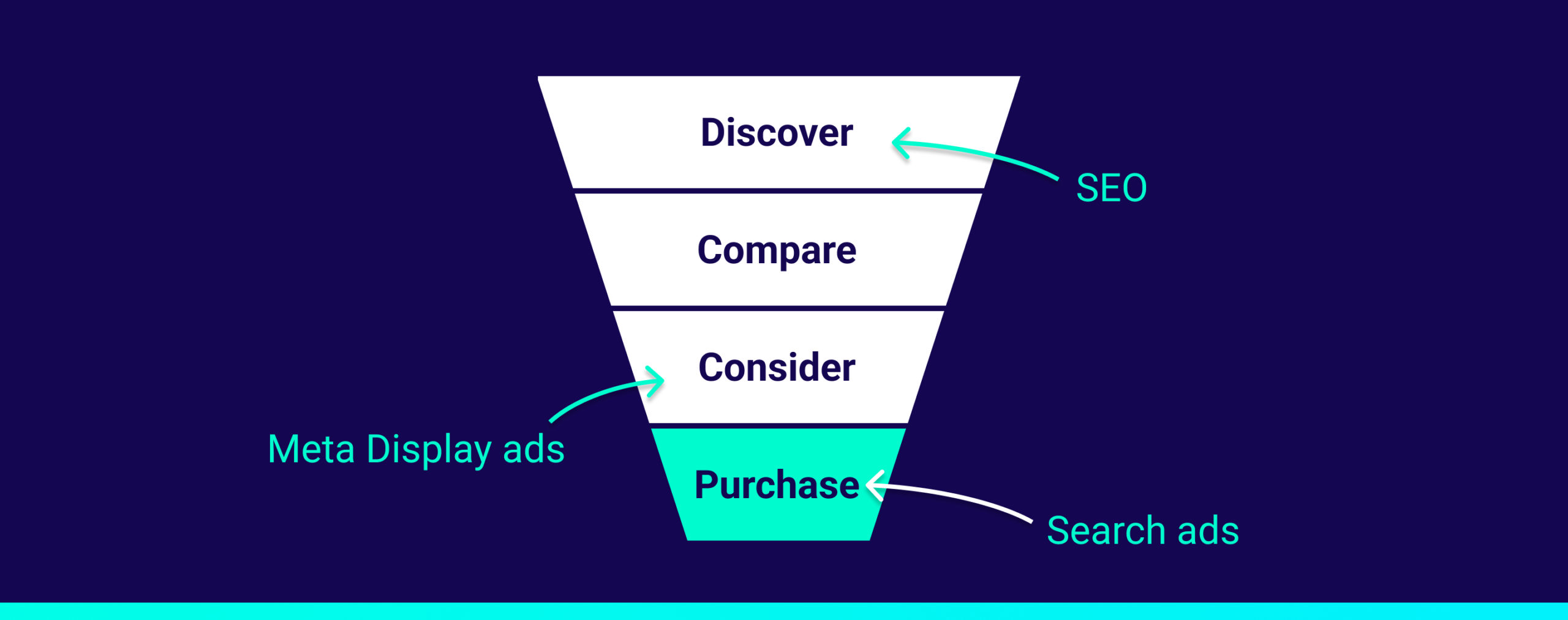Identifying which marketing options offer the best return on investment can often feel like navigating a maze.
I attended a presentation by Dennis Teichmann where he showcased an intriguing graph (I’ve modified it slightly for this post). I found this to be a very interesting way to represent the different marketing channels available to businesses.

When you consider this, you might find yourself asking some questions:
- What method is the most effective for generating new leads?
- And which has the potential to generate lots of them?
But here’s the catch with Teichmann’s graphic: It’s valid only for the specific case he highlighted in his talk.
In the bigger picture, there are probably as many different use cases as there are different types of companies, and the most effective approach depends on the nature of your business. For instance, for a B2B software company, SEO may be irrelevant. Companies like this may not have enough users searching for their products for SEO to make a difference. Potential customers may even be unaware of a product’s existence.
=> Reaching out directly to decision makers via email or phone with the right message will generate the best results.
But depending on the product or service you offer, the most effective strategy for your business could be very different.
- Is SEO the best option?
- Or Google or Meta Ads?
- How about influencers?
- Pinterest, anyone?
- Or affiliate link building?
Exploring different marketing channels and how they generate traffic
Let’s look at some common marketing channels and consider how they could be effectively used to help your audience find you:
1. SEO (Search Engine Optimisation)
SEO is all about optimising your content so that your product or service ranks higher in the results generated by search engines like Google. For companies with products that users are actively searching for, investing in SEO can lead to increased organic traffic and long-term benefits.
Think long-tail keywords (target phrases or questions of three to five words) and probably a worldwide or language-specific audience. But in many cases, using SEO to specifically target a Swiss-only audience may not be relevant. The effort invested in finding effective search terms could far outstrip the reward.
Oftentimes you will attract traffic from surrounding countries to which you might not be able to sell to.
2. Google and Meta Ads
Paid advertising on platforms like Google and Meta (formerly Facebook) can provide you with immediate visibility. This method is particularly effective if you have a well-defined target audience and a compelling ad strategy. Not to mention a solid marketing budget.
3. Influencer marketing
Collaborating with influencers who have a strong following in your niche can amplify your reach. Influencers can help build trust and drive engagement with their audience.
Unfortunately, there are also a ton of scamfulencers. Finding influencers with real and engaged followers might be tricky. The best approach is inviting influencers to test your products–and this won’t cost you a dime.
4. Pinterest marketing
Pinterest is a visual search engine that can be a goldmine for products with strong visual appeal. It’s an excellent platform for driving traffic and discovering trends. Think jewellery, clothes and furniture.
5. Affiliate marketing
Affiliate marketing involves partnering with individuals or companies who promote your product in exchange for a commission. This can be an effective way to expand your reach with no upfront costs.
Combining multiple channels
Often, the most successful marketing strategies involve finding the right mix of several channels. This approach ensures that you’re reaching your audience at different touchpoints.
Consider a typical marketing funnel for a product like the one below:

In a multi-strategy approach, you may, for example, use SEO to capture organic search traffic for long-tail keywords (the “Discover” stage at top of the funnel) while also running targeted Meta Display ads and working with influencers to boost your reach (the “Consider” stage). To round things off, you’re also ensuring clients or customers find you with Google search ads (to attract those in the “Purchase” phase at the bottom of the funnel).

This approach above is one type of strategy you could adopt, but multi-level strategies don’t always have to look like this. Every project is different.
Tailoring your strategy
The key to selecting the best marketing channel is understanding your target audience and where they spend their time. Conduct market research, analyse your competitors, and experiment with different methods to find what works best for your business.


